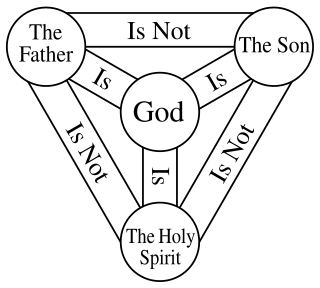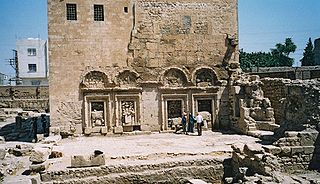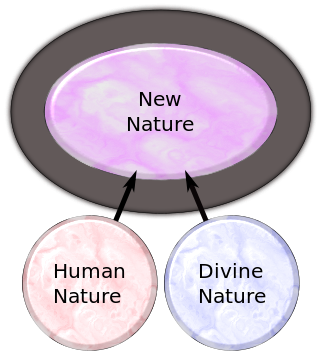The Chalcedonian Definition is the declaration of the dyophysitism of Christ's nature, adopted at the Council of Chalcedon in AD 451. Chalcedon was an early centre of Christianity located in Asia Minor. The council was the fourth of the ecumenical councils that are accepted by Chalcedonian churches which include the Catholic and Orthodox churches.

In Christianity, Christology is a branch of theology that concerns Jesus. Different denominations have different opinions on questions such as whether Jesus was human, divine, or both, and as a messiah what his role would be in the freeing of the Jewish people from foreign rulers or in the prophesied Kingdom of God, and in the salvation from what would otherwise be the consequences of sin.
Nestorianism is a term used in Christian theology and Church history to refer to several mutually related but doctrinarily distinct sets of teachings. The first meaning of the term is related to the original teachings of Christian theologian Nestorius, who promoted specific doctrines in the fields of Christology and Mariology. The second meaning of the term is much wider, and relates to a set of later theological teachings, that were traditionally labeled as Nestorian, but differ from the teachings of Nestorius in origin, scope and terminology. The Oxford English Dictionary defines Nestorianism as:
"The doctrine of Nestorius, Patriarch of Constantinople, by which Christ is asserted to have had distinct human and divine persons."

The Christian doctrine of the Trinity is the central doctrine concerning the nature of God in most Christian churches, which defines one God existing in three coequal, coeternal, consubstantial divine persons: God the Father, God the Son and God the Holy Spirit, three distinct persons (hypostases) sharing one essence/substance/nature (homoousion). As the Fourth Lateran Council declared, it is the Father who begets, the Son who is begotten, and the Holy Spirit who proceeds. In this context, one essence/nature defines what God is, while the three persons define who God is. This expresses at once their distinction and their indissoluble unity. Thus, the entire process of creation and grace is viewed as a single shared action of the three divine persons, in which each person manifests the attributes unique to them in the Trinity, thereby proving that everything comes "from the Father," "through the Son," and "in the Holy Spirit."
Chalcedonian Christianity is a term referring to the branches of Christianity that accept and uphold theological resolutions of the Council of Chalcedon, the fourth ecumenical council, held in 451. Chalcedonian Christianity accepts the Christological Definition of Chalcedon, a Christian doctrine concerning the union of two natures in one hypostasis of Jesus Christ, who is thus acknowledged as a single person (prosopon). Chalcedonian Christianity also accepts the Chalcedonian confirmation of the Niceno-Constantinopolitan Creed, thus acknowledging the commitment of Chalcedonism to Nicene Christianity.

Nestorius was an early Christian prelate who served as Archbishop of Constantinople from 10 April 428 to August 431. A Christian theologian from the Catechetical School of Antioch, several of his teachings in the fields of Christology and Mariology were seen as controversial and caused major disputes.
John I of Antioch was Patriarch of Antioch (429–441). He led a group of moderate Eastern bishops during the Nestorian controversy. He is sometimes confused with John Chrysostom, who is occasionally also referred to as John of Antioch, though John of Antioch is indeed mentioned in the Book of the Miracles of the Blessed Virgin Mary. John gave active support to his friend Nestorius in the latter's dispute with Cyril of Alexandria. In the year 431, he arrived too late for the opening meeting of the First Council of Ephesus. Cyril, suspecting John of using procrastinating tactics to support Nestorius, decided not to wait and convened the council without John and his supporters, condemning Nestorius. When John reached Ephesus a few days after the council had begun, he convened a counter-council that condemned Cyril and vindicated Nestorius.

Theodore of Mopsuestia was a Christian theologian, and Bishop of Mopsuestia from 392 to 428 AD. He is also known as Theodore of Antioch, from the place of his birth and presbyterate. He is the best known representative of the middle Antioch School of hermeneutics.

The Catechetical School of Antioch was one of the two major centers of the study of biblical exegesis and theology during Late Antiquity; the other was the School of Alexandria. This group was known by this name because the advocates of this tradition were based in the city of Antioch in Syria, one of the major cities of the ancient Roman Empire. Although there were early interpreters from Antioch, like Theophilus of Antioch, the proper school of exegesis at Antioch belongs to the period of the late fourth and the fifth centuries.
Babai the Great was an early church father of the Church of the East. He set several of the foundational pillars of the Church, revived the monastic movement, and formulated its Christology in a systematic way. He served as a monastic visitor and coadjutor with Mar Aba as unofficial heads of the Church of the East after Catholicos Gregory until 628 AD, leaving a legacy of strong discipline and deep religious Orthodoxy. He is revered in the modern Assyrian Church of the East and Ancient Church of the East.

Henana of Adiabene was a Christian theologian, and headmaster of the School of Nisibis, the main theological center of the Church of the East (571–610).
Hypostatic union is a technical term in Christian theology employed in mainstream Christology to describe the union of Christ's humanity and divinity in one hypostasis, or individual personhood.
Miaphysitism is the Christological doctrine that holds Jesus, the "Incarnate Word, is fully divine and fully human, in one 'nature' (physis)." It is a position held by the Oriental Orthodox Churches and differs from the Chalcedonian position that Jesus is one "person" in two "natures", a divine nature and a human nature (dyophysitism).

Eutychianism, also known as Real Monophysitism, refers to a set of Christian theological doctrines derived from the ideas of Eutyches of Constantinople. Eutychianism is a monophysite understanding of how the human and divine relate within the person of Jesus Christ, with Christ being in one nature and of two, with the humanity of Christ subsumed by the divinity.
Hypostasis, from the Greek ὑπόστασις (hypóstasis), is the underlying state or underlying substance and is the fundamental reality that supports all else. But it is not the same as the concept of a substance. In Neoplatonism the hypostasis of the soul, the intellect (nous) and "the one" was addressed by Plotinus. In Christian theology, the Holy Trinity consists of three hypostases: Hypostasis of the Father, Hypostasis of the Son, and Hypostasis of the Holy Spirit.
Homoiousios is a Christian theological term, coined in the 4th century to identify a distinct group of Christian theologians who held the belief that God the Son was of a similar, but not identical, essence with God the Father.

Dyophysitism is the Christological position that Jesus Christ is one person of one substance and one hypostasis, with two distinct, inseparable natures, divine and human. It is related to the doctrine of the hypostatic union. Those who insisted on the "two natures" formula were referred to as dyophysites.
The social trinitarianism is a Christian interpretation of the Trinity as consisting of three persons in a loving relationship, which reflects a model for human relationships.
Spanish Adoptionism was a Christian theological position which was articulated in Umayyad and Christian-held regions of the Iberian peninsula in the 8th- and 9th centuries. The issue seems to have begun with the claim of archbishop Elipandus of Toledo that – in respect to his human nature – Jesus Christ was adoptive Son of God. Another leading advocate of this Christology was Felix of Urgel. In Spain, Adoptionism was opposed by Beatus of Liebana, and in the Carolingian territories, the Adoptionist position was condemned by Pope Hadrian I, Alcuin of York, Agobard, and officially in Carolingian territory by the Council of Frankfurt (794).
The position of the Eastern Orthodox Church regarding the Filioque controversy is defined by their interpretation of the Bible, and the teachings of the Church Fathers, creeds and definitions of the seven Ecumenical Councils, as well as the decisions of several particular councils of the Eastern Orthodox Church.







